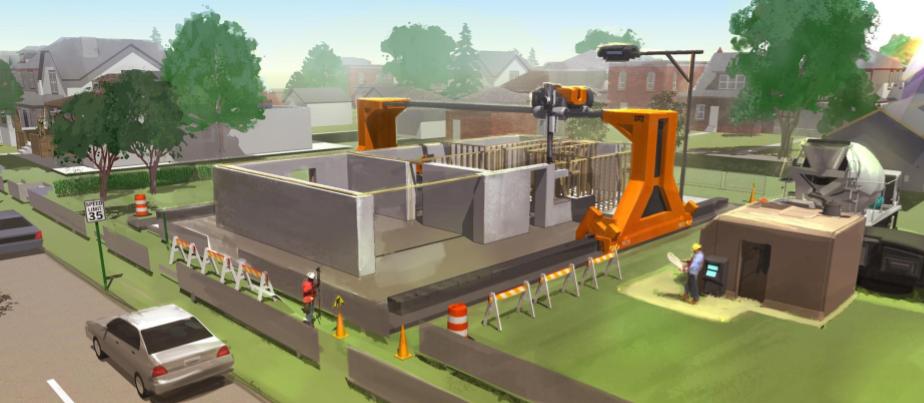SHARE
3D Printing And Its Application In The Construction Industry
3D printing isn’t new to many of us no doubt, but the same cannot be said about the construction industry. Over the years, we’ve come to realize one thine – the construction industry has pretty much remained the same in day to day construction activities save for the use of a few power tools. This was until 2004 when Professor Behrokh Khoshnevis of University of Southern Carolina built the first 3D wall. That act brought the 3D printing technology to a revered position and till date, there have been numerous applications of the technology. Ever since then, sellers of 3D printers have recorded increased sales. In this article, we’ll take a look at the 3D printing application in construction. We’ll also take note of companies that have used these technologies. You can read other articles about 3D printing on our technology blog.
3D Printing in house construction
1. Built 10 3D Printed Houses
In early 2015, Shanghai-based WinSun Decoration Design Engineering built 10 3D printed houses under 24 hours. According to them, each of the houses cost just about $5000 to build. Additionally, a Russian based company known as Apis Cor built a similar structure. They were able to achieve this feat by spraying a mixture of recycled raw materials and quick drying cement using their massive 3D printers. This was done in an offsite location from where the blocks were then transported to the construction site where they are assembled.
2. Development of Contour Crafting Process
As we earlier mentioned, Professor Behrokh Khoshnevis developed a process known as contour crafting. This contour crafting process was instrumental to their building the inner and outer walls of a house. Firstly, the professor designed a 3D printer that was used to test the process on a small scale inside the lab. After achieving good results, he then proceeded to build a bigger 3D printer that could be used in the main construction site. The 3D printer was designed to work on a flat ground slab. On the side of the building, rails were installed on the sides of the area marked for the building. These rails were meant to support the gantry crane that spanned the entire length of the whole building area. The 3D printer had nozzles from which it delivered layers of concrete. The layers of concrete thus build up the inner and outer skins of the wall of the house. Then the company fills the gap in-between with either an insulator or more concrete.
3. Building Disaster Relief Shelters
Although not commercially applied on a large scale, an architectural firm in the US built a small pod-like house with 3D printing technology. The company SOM partnered with the Oak Ridge National Laboratory of the US Department of Energy for this purpose. This eco-friendly house was printed by a special 3D printer designed for the project. The 3D printer worked using a combo of materials including renewable solar and gas energy systems. The end result was a cost-effective off-grid dwelling abode which could also be instrumental in solving housing problems after disasters. The roof of the pod-like house has solar panels installed on it. On the other hand, an integrated battery system stores the energy and uses it to power the house day and night.
Printing of 3D Bridge and Canal
1. Building The World’s First Pedestrian 3D Bridge
On 26th December 2016, the world’s first 3D printed pedestrian bridge was inaugurated in Madrid, Spain. The bridge which is located in the Castilla-La Mancha urban park in Alcobendas was developed by a company called ACCIONA. The bridge measures just 12 meters in length and is 1.75 meters wide. The construction of this bridge was done in phases with the companies involved in the project playing a major role at each stage. First, the architectural design for the bridge was done separately and then the 3D printer was manufactured by another company. The 3D printer was designed to dispose materials only to areas where it was needed. This allowed the bridge to be built with total freedom of forms.
2. Building a Canal
Apart from being used to build a bridge, 3D technology was employed in building a canal in Amsterdam. The project was done in 2014. A special 3D printer was designed for the project. This printer used 3D plastic to construct the canal. The 3D printer is best described as a giant crane-like printing arm. Hence, it was dubbed the Kamermaker which translates to "Room Builder".
Metal Frames For Solid Structures
A Dutch company MX3D created a 3D printing system called the WAAM. WAAM stands for Wire Arc Additive Manufacturing. This process is designed to enable you to create metal structures using 3D printing technology. A special robot with 6-axis was created for this purpose. The robot is equipped with a welder and a nozzle. It welds metal rods layer by layer according to the design already programmed into it. The Dutch company said the robot is a combination of an industrial robot and a giant welding machine. A 3D printed wrap here! The construction world is yet to see the best applications of 3D printing in construction. There’s hope that in the coming years, the technology will be applied on a large scale. This would no doubt, decrease project waiting times, reduce costs significantly and lead to more breakthroughs in 3D printing for the construction industry. Also, we believe NASA will achieve its goals of using 3D printing technology in outer space.
Did you know about this use of 3D printing? Join the engineering community to discover the latest innovations in engineering and participate in challenges.
